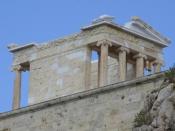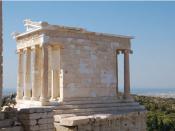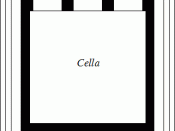This paper will compare and contrast the Temple of Athena Nike (a Greek building) with the Temple of Fortuna Virilis (a Roman building). The Temple of Athena Nike was built in the late fifth century BC, and it is one of the buildings on the Acropolis of Athens. Although it is much smaller than the surrounding structures, the temple has a sense of prominence, because it is the first thing visitors see when they arrive at the Acropolis (Tansey and Kleiner 156). The plan for the temple was created by the architect Kallikrates. It is rectangular in shape, and it contains a small room, known as a cella, with an open doorway at its front. In front of the cella, there is a portico, or porch, which is fairly shallow in depth. The temple as a whole is raised on a three-tiered platform, which is extended in front in order to form steps leading up to the portico.
The original roof is now missing, but it was probably sloped and triangular-shaped, as seen in other Greek temples of the time. There is a row of four columns along the front of the temple, and another row of four columns along the back. A temple having this features (columns on the front and back of the structure, but not on the sides) is referred to as an "amphiprostyle" temple (Kimball and Edgell 76).
The columns of the Temple of Athena Nike are of the Ionic order. As described by Watterson, the principle decoration of the Ionic order "is a double volute or scroll which sweeps across the top of the column with a graceful dip and then curves down on each side and around in an ever diminishing spiral" (Watterson 31). With its distinctive spiral scroll shape on its capital...


